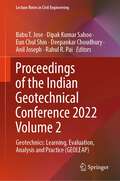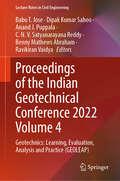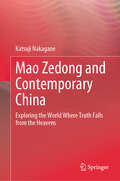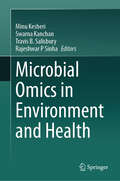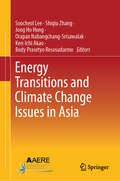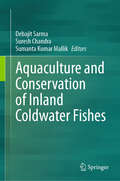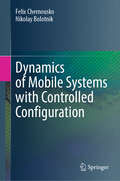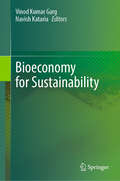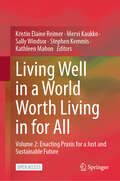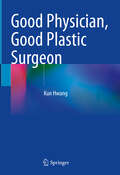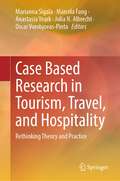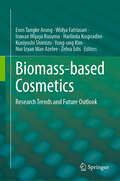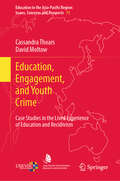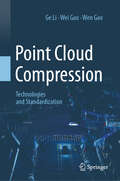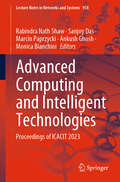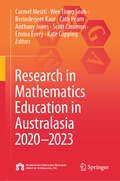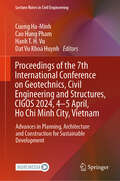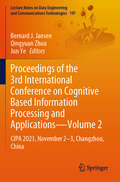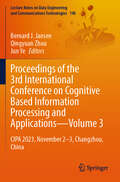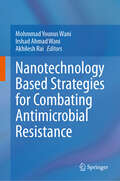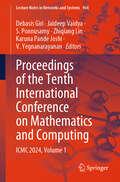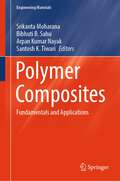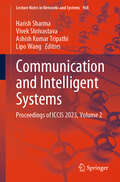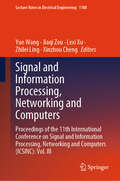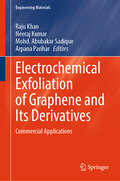- Table View
- List View
Proceedings of the Indian Geotechnical Conference 2022 Volume 2: Geotechnics: Learning, Evaluation, Analysis and Practice (GEOLEAP) (Lecture Notes in Civil Engineering #477)
by Deepankar Choudhury Anil Joseph Babu T. Jose Dipak Kumar Sahoo Eun Chul Shin Rahul R. PaiThis book comprises the select proceedings of the Indian Geotechnical Conference (IGC) 2022. The contents focus on recent developments in geotechnical engineering for a sustainable world. The book covers behaviour of soils and soil–structure interaction, soil stabilization, ground improvement and land reclamation, shallow and deep foundations, geotechnical, geological and geophysical investigation, rock engineering, tunnelling and underground structures, slope stability, landslides and liquefaction, earth retaining structures and deep excavations, geosynthetics engineering, geo-environmental engineering, sustainable geotechnics and landfill design, geo-hydrology, dam and embankment engineering, earthquake geotechnical engineering, transportation geotechnics, forensic geotechnical engineering and retrofitting of geotechnical structures, offshore geotechnics, marine geology and sub-sea site investigation, computational, analytical and numerical modelling, reliability in geotechnical engineering. The contents of this book are useful to researchers and professionals alike.
Proceedings of the Indian Geotechnical Conference 2022 Volume 4: Geotechnics: Learning, Evaluation, Analysis and Practice (GEOLEAP) (Lecture Notes in Civil Engineering #479)
by C. N. V. Satyanarayana Reddy Ravikiran Vaidya Babu T. Jose Dipak Kumar Sahoo Anand J. Puppala Benny Mathews AbrahamThis book comprises the select proceedings of the Indian Geotechnical Conference (IGC) 2022. The contents focus on recent developments in geotechnical engineering for a sustainable world. The book covers behavior of soils and soil–structure interaction, soil stabilization, ground improvement, and land reclamation, shallow and deep foundations, geotechnical, geological and geophysical investigation, rock engineering, tunneling and underground structures, slope stability, landslides and liquefaction, earth retaining structures and deep excavations, geosynthetics engineering, geo-environmental engineering, sustainable geotechnics, and landfill design, geo-hydrology, dam and embankment engineering, earthquake geotechnical engineering, transportation geotechnics, forensic geotechnical engineering and retrofitting of geotechnical structures, offshore geotechnics, marine geology and sub-sea site investigation, computational, analytical and numerical modeling, and reliability in geotechnical engineering. The contents of this book are useful to researchers and professionals alike.
Mao Zedong and Contemporary China: Exploring the World Where Truth Falls from the Heavens
by Katsuji NakaganeWhat did Mao Zedong bring to China? Mao Zedong, a rare leader who is still regarded as a great hero on the Chinese continent, despite the large number of victims caused by the Great Leap Forward and the Cultural Revolution. He called himself "Qin Shi Huang (First Emperor of Qin)plus Marx". It can be said that he is an entity that combines the power of the emperor and the authority of Marx into one person. This book analyzes the features of Mao Zedong’s thought and philosophy, his understanding of Marxism and class struggle, in particular, his peculiar attitude toward intellectuals, his actions leading to the Great Leap Forward and the Cultural Revolution, which he initiated and involved the entire nation, as well as the analysis of the mechanisms that caused such catastrophes and tragedies. Finally, through these analyses, this book attempts to evaluate Mao Zedong with diverse personalities and his behavior, positive and negative, whether in political, social, economic, or philosophical areas.
Microbial Omics in Environment and Health
by Rajeshwar P. Sinha Minu Kesheri Swarna Kanchan Travis B. SalisburyThis book describes the basic concepts and recent advances in new discoveries and technologies related to microbial omics and their role in environmental research and human health. The term "omics" refers to a blend of high-throughput analysis and traditional methods including genomics, transcriptomics, proteomics, lipidomics and metabolomics for a variety of applications in the field of life sciences, biomedical sciences, environmental sciences, and related industries. The book aims to fill the existing gap in terms of a comprehensive approach that incorporates recent advances in this dynamic field and provides an answer to why this field requires an interdisciplinary research approach. The focus of this book is on the applications of genomics, epigenomics, metagenomics, integrative omics, machine learning and microbiome research in environmental health, disease, wastewater epidemiology, antibiotic resistance, drug discovery, cancer, production of secondary metabolites of microbial origin, oxidative stress alleviating mechanisms, etc. The overall construction of this book emphasizes three major perspectives, namely, elaborate knowledge from fundamentals to recent advances in technologies about omics in general and its application in microbiology, environment, and health in particular; illustrative figures capable of easy visualization of complex pathways; and serving as a platform for highly demanded bioinformatics strategies including relevant codes, programming scripts, machine learning and use of artificial intelligence strategies needed to streamline the research outcomes. With global contributions from authors from internationally renowned organizations who excel in relevant research, this book will benefit bibliophiles and prospective audiences from the research fraternity, academia, professionals, and experts in the field of life sciences, biomedical as well as industries related to the development of drug design and novel advances in biotechnological applications.
Energy Transitions and Climate Change Issues in Asia
by Soocheol Lee Ken-Ichi Akao Budy Prasetyo Resosudarmo Shiqiu Zhang Jong Ho Hong Orapan Nabangchang-SrisawalakThe rapid pace of economic development and urbanization in Asia have led to several major problems such as greenhouse gas emissions, mass consumption, and depletion of natural resources. These problems pose a major threat to a sustainable future for Asia and are hindering many Asian countries' goal of becoming carbon-neutral by the middle of this century. Solving these problems requires a comprehensive understanding of the nature of energy consumption, exploitation of natural resources, and deterioration of the environment.To accelerate the green energy transition and promote efficient resource use in Asia, a range of policy options and joint efforts among Asian countries will be required, including carbon pricing, resource tax reform, the expansion of transition finance, support for the development of low-carbon, and resource-efficient social infrastructure. However, Asia is home to many countries, each in a different stage of economic development and with its own culture and customs. Practical implementation of these policies will require bringing together researchers, policymakers, and citizens to share their knowledge and engage in discussions to generate policy ideas that are appropriate for each country. The purpose of this book is to share theoretical and empirical knowledge and convey policy implications that can be expected to accelerate energy transition and resource use effectiveness toward a sustainable future in Asia.
Aquaculture and Conservation of Inland Coldwater Fishes
by Suresh Chandra Debajit Sarma Sumanta Kumar MallikThis book provides the latest information on trans-Himalayan Hindu Kush Region (HKR) fisheries including the Indian Himalayan Region (IHR) as well as the historical context of its sustainable development for improving livelihood and nutritional security. The book serves as an important document to provide knowledge and information about the major concerns of environmental and anthropogenic factors that have impacted the population of certain important fishes in the ecosystem and the strategies and policies required for the conservation of these important groups of fishes, viz., Mahseer, snow trout, minor carp, catfishes, etc. The chapters describe the information to the readers on potential cold water and cool water fish species suitable for large-scale farming and propagation addressing the issues of diseases, nutrigenomics, and nanobiotechnology. This book also addresses the prospects and potential of recreational fishing in India and the scope for its improvement to generate more employment and income citing the success stories and primary information from reputed anglers. Finally, the book also elucidates a comprehensive yet representative description of many challenges associated with inland coldwater- cool water fisheries and aquaculture in HKR, IHR, and its way forward.
Dynamics of Mobile Systems with Controlled Configuration
by Felix Chernousko Nikolay BolotnikThe book discusses the dynamics and control of motion for mobile robots and other systems capable of moving in various environments by modifying their configurations. It is intended for researchers and engineers in theoretical and applied mechanics, robotics, control theory, and biomechanics. Additionally, graduate and post-graduate students studying these disciplines will find it a useful resource.
Bioeconomy for Sustainability
by Vinod Kumar Garg Navish KatariaThis edited volume covers the key role of bioeconomy for next-generation industrial production to achieve Sustainable Development Goals. It addresses the key environmental challenges due to biowaste generation and their application in boosting the economy through the conversion of biowaste into valuable products for sustainable growth and future needs. This book also describes the potential future research scope and possibilities in bioeconomy towards sustainable industrial ecology and circular economy. In recent years, competition has increased for determinate resources. There is an urgent need to look for sustainable, non-polluting alternate sources to meet the demands of an ever-increasing population. Sustainable processes and production while using biological material can produce food, fodder, agricultural inputs, fuel etc. with lesser inputs and reduced emission of pollutants. Agricultural waste and food waste are another concern which demands immediate interventions. The Bioeconomy can be a possible way to address these challenges. It includes sustainable production of food, fodder, fiber, fuel, agricultural inputs, and other goods while using renewable resources or different types of waste. This is beneficial to resolve diverse environmental problems such as future bioenergy production technology, societal transformations, pollution management, industrial circular economy, agricultural practices and food securities, climate management etc. Bioeconomy helps to move from a linear economy to a circular economy. This book is a valuable source for researchers, teachers, and undergraduate and graduate students of environmental science, environmental economics, agriculture science, biotechnology, ecology, and soil science. It also serves as additional reading material for professionals, scientists, stakeholders of government and non-government organizations, industrialists, and policymakers of the relevant fields.
Living Well in a World Worth Living in for All: Volume 2: Enacting Praxis for a Just and Sustainable Future
by Stephen Kemmis Kathleen Mahon Mervi Kaukko Kristin Elaine Reimer Sally WindsorThis open access book is the second of a two-volume series that explores how people are living well and creating a “World Worth Living in for All”. It engages in deep listening of voices from across the world and considers the role of education in creating a more just and sustainable world for the future. The book asks what can be learnt to create change in policy and practice in order to enact praxis. It showcases chapters from international authors who discuss current or new projects to address the overarching questions explored in the book. It also provides an overview of perspectives that connect both volumes and the individual projects presented together through the lens of practice architectures.
Good Physician, Good Plastic Surgeon
by Kun HwangThis book is based on over 100 editorials published in various international academic journals. Within its pages, the author engages in discussions with esteemed plastic surgeons, exploring the qualities that define a good plastic surgeon, the intricate connection between anatomy and plastic surgery, the concept of beauty, the process of aging, and the interplay between arts and plastic surgery. Each case presented in the book is both captivating and educational, with the author thoughtfully including a corresponding figure or schema for visual reference. This book promises to be an invaluable resource, particularly for young plastic surgeons or those undergoing plastic surgery training.
Case Based Research in Tourism, Travel, and Hospitality: Rethinking Theory and Practice
by Julia N. Albrecht Marianna Sigala Anastasia Yeark Marcela Fang Oscar Vorobjovas-PintaThis book consolidates case study based research in tourism, travel, hospitality, and events under one roof. It aims to consolidate cutting edge case study based research within the wider tourism industry that investigates topical and contemporary industry challenges and practices, which in turn can help tourism scholars to build new theory for advancing tourism research and educational practices. Case study based research is well recognised for its ability to develop theories and to support pedagogical aims. This book explores the repercussions of COVID-19 on tourism in how this has magnified the need and the urgency to use case based research and teaching. COVID-19 has accelerated profound changes in the tourism industry that are demonstrated in transformed: consumer profiles and behaviours; industry structures, business models and operations; and tourism labour markets. Subsequently, tourism educators, providers and researchers are required to study andaddress the abovementioned changes by undertaking transformational tourism research that can challenge and shift existing theories and knowledge frontiers, help industry and academia alike to reset new industry standards; and 2) develop tourism graduates that meet the new industry requirements, are resilient, flexible and adaptable, they possess transferable knowledge and skills that can solve real industry problems. The aim of this book to meets the market gap of books focusing on case study based research and teaching and further expands to address the COVID-19 repercussions and opportunities for tourism research and case studies.
Biomass-based Cosmetics: Research Trends and Future Outlook
by Widya Fatriasari Enos Tangke Arung Irawan Wijaya Kusuma Harlinda Kuspradini Kuniyoshi Shimizu Yong-Ung Kim Nur Izyan Wan Azelee Zehra EdisThis book highlights the potential of biomass for cosmetics applications. It covers the discussion on biomass as a source for cosmetics from savanna, marine and tropical forest, trend and market outlook of biobased cosmetics, active substances from biomass for cosmetics, extractives from biomass for cosmetics, other non-wood forest products such as essential oil, tengkawang, and bee pollen. Besides that, the potency of biopolymers such as lignin, and polysaccharides are presented. The book also discusses activated carbon as a cosmetic source. To present more comprehensive information, it covers biomass as anti-aging, anti-acne, sunscreen, anti-melanin, and antimicrobial. Regarding the close contact system with the human in daily life, cosmetic needs to comply with the human system. Therefore, one special chapter is dedicated to presenting the compatibility view of biobased cosmetics in the human body system. Nanomaterials in cosmetics have started to be used by many beauty companies asindicated by nano-related patents. The nanotechnology applications in cosmetics also provide future trends in bio-based cosmetics. Some forms of nanomaterials that have been reported include liposomes, nanoemulsion, nanocapsules, solid lipid nanoparticles, nanocrystals, nano-silver, nano-gold, hydrogel, etc. Iodinated Aloe Vera formulations within polymeric complexes present examples of bio-antimicrobials and such compounds are at the crossroads between pharmaceutics and cosmetics. Finally, the environmental and safety impacts of biobased cosmetic development are discussed as the closure in the last chapter.This book is expected to provide insightful information for those dealing with biomass or doing research on biomass for sustainable living. Moreover, it is also suitable for policymakers to get the new and latest information on valorizing local biomass while expanding its usage for cosmeceutical purposes. Due to the current environmental problems occurring in our surroundings, this book is seen to be an important tool to spread awareness of the smart way of utilizing our precious biomass and transforming it into valuable products.
Education, Engagement, and Youth Crime: Case Studies in the Lived Experience of Education and Recidivism (Education in the Asia-Pacific Region: Issues, Concerns and Prospects #71)
by Cassandra Thoars David MoltowThis book presents insights into how affective educational experiences may be associated with youth criminal behaviour and the pathway to recidivism. It explores the perspectives and lived school experiences of five young adult male prison inmates, including while they were incarcerated as youths. Through these case studies, the book explores the relationship between affective engagement in education and recidivism.This book shows that participants were affectively disengaged from education prior to their initial incarceration in a youth detention facility, and that their disaffection before, during, and after youth incarceration both generated and impacted on their cognitive and behavioural disengagement from education. Moreover, a range of additional factors not directly causally related to their schooling were shown to have had a significant effect on their engagement in education. The book considers a number of key findings. First, the foundational role that a sense of belonging plays in how young people experience education and its relation to crime. Second, the importance of individualized transition plans for youth at risk, and youth offenders before, during, and after incarceration. Third, the extent to which successful transition from youth offending and recidivism hinges on interagency collaboration. This book will be beneficial to teacher educators, education researchers, criminologists and sociologists.
Point Cloud Compression: Technologies and Standardization
by Wen Gao Wei Gao Ge Li3D point clouds have broad applications across various industries and have contributed to advancements in fields such as autonomous driving, immersive media, metaverse, and cultural heritage protection. With the fast growth of 3D point cloud data and its applications, the need for efficient compression technologies has become paramount. This book delves into the forefront of point cloud compression, exploring key technologies, standardization efforts, and future prospects. This comprehensive book uncovers the foundational concepts, data acquisition methods, and datasets associated with point cloud compression. By examining the fundamental compression technologies, readers can obtain a clear understanding of prediction coding, transform coding, quantization techniques, and entropy coding. Through vivid illustrations and examples, the book elucidates how these techniques have evolved over the years and their potentials for the future. To provide a complete picture, the book presents cutting-edge research methods in point cloud compression and facilitates comparisons among them. Readers can be equipped with an in-depth understanding of the latest advancements, and can gain insights into the various approaches employed in this dynamic field. Another distinguishing aspect of this book is its exploration of standardization works for point cloud compression. Notable standards, such as MPEG G-PCC, AVS PCC, and MPEG V-PCC, are thoroughly illustrated. By delving into the methods used in geometry-based, video-based, and deep learning-based compression, readers become familiar with the latest breakthroughs in the standard communities.
Advanced Computing and Intelligent Technologies: Proceedings of ICACIT 2023 (Lecture Notes in Networks and Systems #958)
by Marcin Paprzycki Monica Bianchini Ankush Ghosh Rabindra Nath Shaw Sanjoy DasThis book gathers selected high-quality research papers presented at International Conference on Advanced Computing and Intelligent Technologies (ICACIT 2023), which is organized by Indira Gandhi National Tribal University, Regional Campus Manipur (IGNTU-RCM), during December 8–9, 2023. It discusses emerging topics pertaining to advanced computing, intelligent technologies and networks including AI and machine learning, data mining, big data analytics, high-performance computing network performance analysis, Internet of things networks, wireless sensor networks, and others. The book offers an asset for researchers from both academia and industries involved in advanced studies.
Research in Mathematics Education in Australasia 2020–2023
by Scott Cameron Berinderjeet Kaur Wee Tiong Seah Anthony Jones Carmel Mesiti Cath Pearn Emma Every Kate CoppingThis book provides a critical review of research in mathematics education published in or about the Australasian region in the four years from 2020 to 2023. Research in Mathematics Education in Australasia 2020-2023 (RiMEA 2020-2023) is the eleventh edition of the four-yearly review of mathematics education research in Australasia. It is compiled by the Mathematics Education Research Group of Australasia (MERGA). It is primarily focused on research from Australia, New Zealand, and Singapore but also includes research from other Southeast Asian countries and the South Pacific. Although each edition of RiMEA is shaped by the preceding volumes, each new edition evolves in response to events coinciding with each new review period. Following an introduction by the editors, RiMEA 2020-2023 will contain a reflection chapter authored by the editors of the previous edition, 'Research in Mathematics Education in Australasia 2016–2019,' on how research in mathematics education in theAustralasian region has progressed over the four years since. This book provides a comprehensive critical review of research literature in the Australasian region on significant topics published within the review period. It serves as a resource for researchers and promotes quality research in the Australasian region. Furthermore, it provides an introduction to mathematics education research in the Australasian region for Ph.D. candidates, early career researchers, and other researchers beginning a new field of research.
Proceedings of the 7th International Conference on Geotechnics, Civil Engineering and Structures, CIGOS 2024, 4-5 April, Ho Chi Minh City, Vietnam: Advances in Planning, Architecture and Construction for Sustainable Development (Lecture Notes in Civil Engineering #482)
by Cuong Ha-Minh Dat Vu Khoa Huynh Cao Hung Pham Hanh T. H. VuThis book includes peer-reviewed articles from the 7th International Conference on Geotechnics, Civil Engineering and Structures (CIGOS 2024) held on April 4-5 in Ho Chi Minh City, Vietnam. It highlights recent advances in planning, architecture, and construction for sustainable development. The book features a compilation of articles presented at the conference, bringing together researchers, academics, and practitioners from around the world. The topics covered range from Planning, Architecture, and Industrial Design to Construction, Materials, Structures, and Digital Technologies, as well as Geoscience, Environment, and Energy, and Transportation, Infrastructure, Management, and Investment. The book emphasizes the importance of a multidisciplinary approach to sustainable development in order to address environmental, social, and economic challenges faced by societies worldwide. It provides insights into best practices and innovative approaches for achieving sustainabledevelopment goals, such as reducing the carbon footprint, enhancing energy efficiency, promoting the use of eco-friendly materials, and implementing sustainable construction techniques. Overall, this book offers valuable knowledge and advice to professionals, researchers, and policymakers engaged in sustainable development initiatives.
Proceedings of the 3rd International Conference on Cognitive Based Information Processing and Applications—Volume 2: CIPA 2023, November 2—3, Changzhou, China (Lecture Notes on Data Engineering and Communications Technologies #197)
by Jun Ye Bernard J. Jansen Qingyuan ZhouThis book contains papers presented at the 3rd International Conference on Cognitive- based Information Processing and Applications (CIPA) in Changzhou, China, from November 2–-3, 2023. The papers represent the various technological advancements in theory, technology and application of artificial intelligence, including precision mining, intelligent computing, deep learning, and all other theories, models, and technologies related to artificial intelligence. It caters to postgraduate students, researchers, and practitioners specializing and working in the area of cognitive-inspired computing and intelligent computing. The book represents Volume 2 for this conference proceedings, which consists of a 3-volume book series.
Proceedings of the 3rd International Conference on Cognitive Based Information Processing and Applications—Volume 3: CIPA 2023, November 2–3, Changzhou, China (Lecture Notes on Data Engineering and Communications Technologies #198)
by Jun Ye Bernard J. Jansen Qingyuan ZhouThis book contains papers presented at the 3rd International Conference on Cognitive- based Information Processing and Applications (CIPA) in Changzhou, China, from November 2–3, 2023. The papers represent the various technological advancements in theory, technology and application of artificial intelligence, including precision mining, intelligent computing, deep learning, and all other theories, models, and technologies related to artificial intelligence. It caters to postgraduate students, researchers, and practitioners specializing and working in the area of cognitive-inspired computing and intelligent computing. The book represents Volume 3 for this conference proceedings, which consists of a 3-volume book series.
Nanotechnology Based Strategies for Combating Antimicrobial Resistance
by Mohmmad Younus Wani Irshad Ahmad Wani Akhilesh RaiThis book provides a comprehensive overview of recent advances in nanotechnology as an alternative strategy for addressing antimicrobial resistance (AMR). Examining nanotechnology-based methods such as nanoencapsulation, drug delivery, and conjugation, the text highlights their successful application in treating microbial infections with reduced resistance and off-target toxicity. The introductory section outlines AMR and explores diverse mechanisms of microbial resistance, emphasizing the potential of nanotechnology to surmount these challenges. Subsequent chapters investigate the role of specific nanomaterials—metal nanoparticles, metal oxide nanoparticles, functionalized quantum dots, magnetic nanoparticles, bimetallic nanoparticles, nanocomposites, carbon nanomaterials, and polymer-based nanomaterials—in overcoming antimicrobial resistance. Several chapters focus on the efficacy of nanoemulsions as an antimicrobial delivery method, underscoring their inherent antimicrobial properties, capacity to enhance drug solubility, stability, bioavailability, and targeting potential at the organ and cellular levels. The concluding section provides a detailed review of liposomes, dendrimers-based nanoparticles, and micelles as drug delivery vehicles in the context of combating pathogens resistant to antimicrobials.
Proceedings of the Tenth International Conference on Mathematics and Computing: ICMC 2024, Volume 1 (Lecture Notes in Networks and Systems #964)
by S. Ponnusamy Debasis Giri Jaideep Vaidya Zhiqiang Lin Karuna Pande Joshi V. YegnanarayananThis book features selected papers from the 10th International Conference on Mathematics and Computing (ICMC 2024), held at Kalasalingam Academy of Research and Education (KARE), Krishnankoil, India during 2 – 7 January 2024. It covers recent advances in the field of mathematics, statistics, and scientific computing. The book presents innovative work by leading academics, researchers, and experts from industry in mathematics, statistics, cryptography, network security, cyber security, machine learning, data analytics and blockchain technology in computer science and information technology. The book is divided into two volumes.
Polymer Composites: Fundamentals and Applications (Engineering Materials)
by Santosh K. Tiwari Srikanta Moharana Bibhuti B. Sahu Arpan Kumar NayakThis book highlights the fundamentals and recent advances for developing novel polymer composites for various applications, including 3D printing, automotive, textiles, agriculture, nanogenerators, energy storage and biomedical engineering. It presents various facile processing techniques to prepare polymeric composites with attractive properties like mechanical strength, flexibility, thermal & electrical performances for end used applications from bench to field. This in-sight of properties, performances and utility will lead to technological applications of polymer composites. It provides a platform for evolving and expanding technological solutions for challenges in the contemporary world, and presents a concrete path for advancement in this domain of polymer composite for professionals, researchers, material scientists, and students.
Communication and Intelligent Systems: Proceedings of ICCIS 2023, Volume 2 (Lecture Notes in Networks and Systems #968)
by Lipo Wang Harish Sharma Vivek Shrivastava Ashish Kumar TripathiThis book gathers selected research papers presented at the Fifth International Conference on Communication and Intelligent Systems (ICCIS 2023), organized by Malaviya National Institute of Technology Jaipur, India, during December 16–17, 2023. This book presents a collection of state-of-the-art research work involving cutting-edge technologies for communication and intelligent systems. Over the past few years, advances in artificial intelligence and machine learning have sparked new research efforts around the globe, which explore novel ways of developing intelligent systems and smart communication technologies. The book presents single- and multi-disciplinary research on these themes to make the latest results available in a single, readily accessible source. The work is presented in three volumes.
Signal and Information Processing, Networking and Computers: Proceedings of the 11th International Conference on Signal and Information Processing, Networking and Computers (ICSINC): Vol. III (Lecture Notes in Electrical Engineering #1188)
by Yue Wang Lexi Xu Jiaqi Zou Zhilei Ling Xinzhou ChengThis book collects selected papers from the 11th Conference on Signal and Information Processing, Networking and Computers held in Chengdu, China, in September 2023. The book focuses on the current works of information theory, communication system, computer science, aerospace technologies, big data, and other related technologies. People from both academia and industry of these fields can contribute and find their interests from the book.The 11th International Conference on Signal and Information Processing, Networking and Computers (ICSINC) was held in Chengdu, China, in September 2023, which focused on the key technologies and challenges of signal and information processing schemes, network application, computer theory, space technologies, big data, and other related technologies
Electrochemical Exfoliation of Graphene and Its Derivatives: Commercial Applications (Engineering Materials)
by Neeraj Kumar Raju Khan Arpana Parihar Mohd. Abubakar SadiqueThe book describes the technique of electrochemical exfoliation, which possesses remarkable ability to bring about transformation. Among various known synthesis methods, the electrochemical exfoliation approach eliminates the use of harsh chemicals and energy-intensive methods commonly linked to the synthesis of graphene. Electrochemical exfoliation utilizes electrical energy to gently remove layers of graphene from its original source, providing a more environmentally friendly method. This precise and careful synchronization heralds a new era in the field of materials science, where the principles of sustainability converge with unmatched performance. Moreover, the benefits extend beyond environmental excellence. This book also examines the complexities of electrochemical exfoliation, highlighting its clear advantage over traditional techniques. The approach demonstrates process in manipulating the structure and properties of graphene, allowing for the customization of specific capabilities to suit a wide range of applications.
